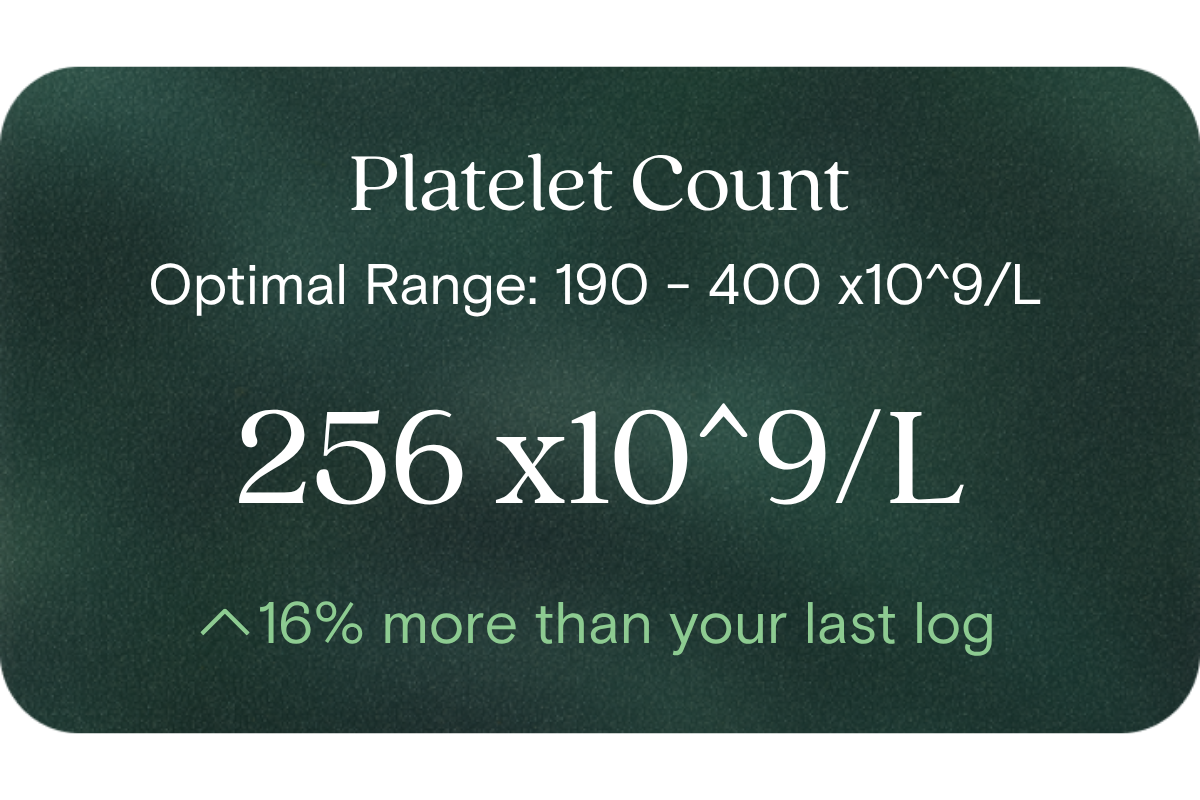What is platelet count?
Platelet count is a measurement of how many platelets (thrombocytes) are present in each litre of blood, reported in ×10⁹/L (i.e. billions per litre). Platelets are small, anucleate fragments derived from bone marrow megakaryocytes. They circulate in an inactive state until vessel injury or signals trigger them to adhere, activate, and aggregate to begin the process of clot formation and wound sealing.
Why does platelet count matter for long-term health and wellbeing?
Your platelet count offers a subtle readout of how well your circulatory, immune and regenerative systems are balanced. It ties into your body’s capacity to respond to micro-injury, maintain vascular integrity, and regulate inflammatory or stress signals. If platelet levels drift over time, that may indicate shifts in bone marrow health, systemic inflammation, medication effects, or lifestyle stressors — giving you a chance to correct course in diet, rest, recovery or environmental exposures before more serious issues develop.
What’s an optimal level of platelet count?
- Laboratory reference (typical range in Australia): 150 to 400 ×10⁹/L
- “Optimal” zone: There is no universally agreed “optimal” narrower band beyond the reference range, but many health-oriented platforms may aim for the mid to upper half of the normal range (for example, ~200 to 350 ×10⁹/L), assuming all else is healthy and stable.
- Critical thresholds: Below ~20 ×10⁹/L spontaneous bleeding becomes a concern. Values consistently above 400 (or the upper lab cut) may trigger further investigation into reactive or marrow stimuli.
What influences platelet count levels?
Platelet counts are modulated by bone marrow production rate, platelet lifespan (turnover), consumption (for example in micro-injury or inflammation), and sequestration (e.g. in the spleen). Influences include genetics, immune regulation, certain medications, nutritional status (e.g. B 12, folate, iron), hormonal changes (e.g. pregnancy), chronic stress or inflammation, and underlying chronic conditions. Physiological states such as pregnancy often lead to modest declines, and some medications may suppress platelet production or increase destruction.
What does it mean if platelet count is outside the optimal/reference range?
- If your count is below the lower limit (e.g. <150 ×10⁹/L), it may reflect decreased production, increased destruction or consumption, or sequestration — and you may have decreased buffer against bleeding or injury.
- If your count is above the upper limit (e.g. >400 ×10⁹/L), it could reflect a reactive increase (for example due to inflammation, stress, or recovery stimulus) or a stronger bone-marrow drive. Either direction warrants further insight (especially if sustained) so you can identify modifiable triggers (nutrition, stress, inflammation) early.
How can I support healthy platelet count levels?
You can support platelet health by:
- Optimising micronutrients important for blood cell formation (e.g. B 12, folate, iron)
- Maintaining good sleep, recovery and stress management
- Reducing chronic inflammatory load (dietary choices, pollutants, excess training stress)
- Reviewing medications or supplements that may interfere with platelet dynamics
- Ensuring overall bone-marrow support via adequate protein, rest, and general metabolic health
Tracking your platelet count (alongside other biomarkers) helps you see how changes in lifestyle or environment map onto your internal resilience and repair capacity.
This information is provided for general health and wellness purposes only and does not replace medical advice.
References
- Pathology Tests Explained. (2024). Platelet count. Pathology Tests Explained Australia.
- Royal College of Pathologists of Australasia. (2024). RCPA Manual: Platelet count.
- Proietti, S., McQuilten, Z., & Wood, E. (2020). Review of full blood count reference interval using a large cohort of first-time plasmapheresis blood donors. Pathology, 52(5), 538–543.




















.png)
